Feasibility Study of Pervious Concrete with Ceramsite as Aggregate Considering Mechanical Properties, Permeability, and Durability
Abstract
1. Introduction
2. Materials and Methods
2.1. Raw Materials
2.2. Mix Design and Specimen Preparation of Pervious Concrete
2.3. Experimental Tests
3. Results and Discussion
3.1. Compressive Strength Analysis Considering Water–Cement Ratio and Aggregate Type
3.2. Permeability Coefficient Analysis Considering Water–Cement Ratio and Aggregate Type
3.3. Freeze–Thaw Durability Analysis of Pervious Concrete with Ceramsite
3.4. Discussion on Reinforcement of Bonding Surface of Pervious Concrete
4. Conclusions
- As the water–cement ratio increased, the compressive strength of pervious concrete generally decreased due to higher water content and lower cement ratio in the cement slurry. The thickness and bonding area of the cement slurry layer were directly determined by the aggregate–cement ratio. Compressive strength was mainly provided by the strength of aggregates, with the highest 28-day compressive strength being that of high-strength clay ceramsite, followed by ordinary crushed-stone aggregates and lightweight ceramsite.
- Pervious concrete’s permeability coefficient decreased with the water–cement ratio due to a decrease in aggregate porosity. Porosity was influenced by aggregate particle size and shape, with larger particles resulting in larger porosity and permeability coefficients. Among different aggregates, lightweight ceramsite had the highest permeability coefficient, followed by high-strength clay ceramsite and ordinary crushed-stone aggregates.
- The quality of pervious concrete decreased as the freeze–thaw cycles increased, which was caused by internal tension between cementitious material and aggregates. After 25 freeze–thaw cycles, the quality loss was 1.52%. Similarly, compressive strength decreased due to reduced bonding strength between cementitious material and aggregates. After 25 freeze–thaw cycles, the compressive strength loss rate was 6.84%.
- Linear regression analysis was used to measure the relationship between the water–cement ratio and the compressive strength or permeability coefficient of pervious concrete. The models showed a strong correlation, with R2 values of approximately 0.94 and 0.9, indicating a good regression fit. Quadratic polynomial regression analysis was employed to assess the relationship of durability and freeze–thaw cycles, yielding an R2 value of around 0.98. After 25 freeze–thaw cycles, pervious concrete specimens exhibited only a small area of detachment of ceramic particles on the surface.
Author Contributions
Funding
Institutional Review Board Statement
Informed Consent Statement
Data Availability Statement
Conflicts of Interest
References
- Tan, G.J.; Zhu, Z.Q.; Wang, W.S.; He, X.; Zhang, S.F.; Wei, X.L.; Wan, F.H. Durability evaluation of pp-ecc with local superfine sand (sspp-ecc) serviced in seasonal frozen region. Constr. Build. Mater. 2023, 366, 130278. [Google Scholar] [CrossRef]
- Jeon, I.K.; Qudoos, A.; Kim, H.G. Influence of carbonation curing on hydration and microstructure of magnesium potassium phosphate cement concrete. J. Build. Eng. 2021, 38, 102203. [Google Scholar] [CrossRef]
- Prakash, R.; Divyah, N.; Srividhya, S.; Avudaiappan, S.; Amran, M.; Raman, S.N.; Guindos, P.; Vatin, N.I.; Fediuk, R. Effect of steel fiber on the strength and flexural characteristics of coconut shell concrete partially blended with fly ash. Materials 2022, 15, 4272. [Google Scholar] [CrossRef] [PubMed]
- Prakash, R.; Raman, S.N.; Subramanian, C.; Divyah, N. Eco-friendly fiber-reinforced concretes. In Handbook of Sustainable Concrete and Industrial Waste Management; Elsevier: Amsterdam, The Netherlands, 2022. [Google Scholar] [CrossRef]
- Zhao, J.; Zheng, J.J.; Peng, G.F.; Sun, P.S. Spalling and cracking modelling of high-performance concrete exposed to elevated temperatures. Mag. Concr. Res. 2017, 69, 1276–1287. [Google Scholar] [CrossRef]
- Li, X.Z.; Wang, H.; Wang, J.M.; Liu, J.Z. Experimental analysis of reinforcement rust in cement under corrosive environment. Coatings 2021, 11, 241. [Google Scholar] [CrossRef]
- Sarker, P.K.; Kelly, S.; Yao, Z.T. Effect of fire exposure on cracking, spalling and residual strength of fly ash geopolymer concrete. Mater. Des. 2014, 63, 584–592. [Google Scholar] [CrossRef]
- Prakash, R.; Thenmozhi, R.; Raman, S.N.; Subramanian, C.; Divyah, N. An investigation of key mechanical and durability properties of coconut shell concrete with partial replacement of fly ash. Struct. Concr. 2020, 22, E985–E996. [Google Scholar] [CrossRef]
- Liu, R.T.; Liu, H.J.; Sha, F.; Yang, H.L.; Zhang, Q.S.; Shi, S.S.; Zheng, Z. Investigation of the porosity distribution, permeability, and mechanical performance of pervious concretes. Processes 2018, 6, 78. [Google Scholar] [CrossRef]
- Cai, X.; Li, F.; Guo, X.W.; Li, R.; Zhang, Y.A.; Liu, Q.H.; Jiang, M.M. Research progress of eco-friendly portland cement porous concrete: A review. J. Renew. Mater. 2022, 11, 103–130. [Google Scholar] [CrossRef]
- Njiki, G.N.; Ambroise, J.; Pera, J. Influence of chemical admixture on the properties of porous and draining cement concrete. Mater. Struct. 2000, 33, 647–654. [Google Scholar]
- Bahraq, A.A.; Jose, J.; Shameem, M.; Maslehuddin, M. A review on treatment techniques to improve the durability of recycled aggregate concrete: Enhancement mechanisms, performance and cost analysis. J. Build. Eng. 2022, 55, 104713. [Google Scholar] [CrossRef]
- Kim, H.K.; Lee, H.K. Influence of cement flow and aggregate type on the mechanical and acoustic characteristics of porous concrete. Appl. Acoust. 2010, 71, 607–615. [Google Scholar] [CrossRef]
- Zhang, K.; Yin, W.; Chen, X.; Li, H.; Cao, M.X.; Zhu, S.X. The feasibility of hydroxypropyl methylcellulose as an admixture for porous vegetarian concrete using coarse recycled aggregates. Buildings 2022, 12, 676. [Google Scholar] [CrossRef]
- Liu, Q.; Su, L.J.; Xiao, H.; Xu, W.N.; Yan, W.M.; Xia, Z.Y. Preparation of shale ceramsite vegetative porous concrete and its performance as a planting medium. Eur. J. Environ. Civ. Eng. 2019, 25, 2111–2126. [Google Scholar] [CrossRef]
- Tang, V.T.; Pakshirajan, K. Novel advanced porous concrete in constructed wetlands: Preparation, characterization and application in urban storm runoff treatment. Water Sci. Technol. 2018, 78, 2374–2382. [Google Scholar] [CrossRef]
- Zhong, R.; Wille, K. Material design and characterization of high performance pervious concrete. Constr. Build. Mater. 2015, 98, 51–60. [Google Scholar] [CrossRef]
- Li, X. Experimental Study on the Effect of Vibration Mixing on the Performance of Permeable Concrete. Master’s Thesis, Changan University, Xi’an, China, 2019. [Google Scholar]
- Pieralisi, R.; Cavalaro, S.H.P.; Aguado, A. Discrete element modelling of the fresh state behavior of pervious concrete. Cem. Concr. Res. 2016, 90, 6–18. [Google Scholar] [CrossRef]
- Santamouris, M. Using cool pavements as a mitigation strategy to fight urban heat island—A review of the actual developments. Renew. Sustain. Energy Rev. 2013, 26, 224–240. [Google Scholar] [CrossRef]
- Liu, Y.; Li, T.; Peng, H. A new structure of permeable pavement for mitigating urban heat island. Sci. Total Environ. 2018, 634, 1119–1125. [Google Scholar] [CrossRef]
- Qin, Y.H.; Hiller, J.E. Water availability near the surface dominates the evaporation of pervious concrete. Constr. Build. Mater. 2016, 111, 77–84. [Google Scholar] [CrossRef]
- Zhu, H.T.; Wen, C.C.; Wang, Z.Q.; Li, L. Study on the permeability of recycled aggregate pervious concrete with fibers. Materials 2020, 13, 321. [Google Scholar] [CrossRef] [PubMed]
- Chandrappa, A.K.; Biligiri, K.P. Pervious concrete as a sustainable pavement material—Research findings and future prospects: A state-of-the-art review. Constr. Build. Mater. 2016, 111, 262–274. [Google Scholar] [CrossRef]
- Peng, H.; Yin, J.; Song, W.M. Mechanical and hydraulic behaviors of eco-friendly pervious concrete incorporating fly ash and blast furnace slag. Appl. Sci. 2018, 8, 859. [Google Scholar] [CrossRef]
- Chen, B.; Liu, J.Y. Effect of aggregate on the fracture behavior of high strength concrete. Constr. Build. Mater. 2004, 18, 585–590. [Google Scholar] [CrossRef]
- Asamoto, S.; Ishida, T.; Maekawa, K. Investigations into volumetric stability of aggregates and shrinkage of concrete as a composite. J. Adv. Concr. Technol. 2008, 6, 77–90. [Google Scholar] [CrossRef]
- Ceia, F.; Raposo, J.; Guerra, M.; Julio, E.; de Brito, J. Shear strength of recycled aggregate concrete to natural aggregate concrete interfaces. Constr. Build. Mater. 2016, 109, 139–145. [Google Scholar] [CrossRef]
- Sari, D.; Pasamehmetoglu, A.G. The effects of gradation and admixture on the pumice lightweight aggregate concrete. Cem. Concr. Res. 2005, 35, 936–942. [Google Scholar] [CrossRef]
- Wei, H.; Liu, Y.; Wu, T.; Liu, X. Effect of aggregate size on strength characteristics of high strength lightweight concrete. Materials 2020, 13, 1314. [Google Scholar] [CrossRef]
- Bu, C.M.; Liu, L.; Lu, X.Y.; Zhu, D.X.; Sun, Y.; Yu, L.W.; OuYang, Y.H.; Cao, X.M.; Wei, Q.K. The durability of recycled fine aggregate concrete: A review. Materials 2022, 15, 1110. [Google Scholar] [CrossRef]
- Zheng, Y.X.; Zhang, Y.H.; Zhang, P. Methods for improving the durability of recycled aggregate concrete: A review. J. Mater. Res. Technol. 2021, 15, 6367–6386. [Google Scholar] [CrossRef]
- Toutanji, H.; Goff, C.; Pierce, K.; Fares, H. Using aggregate flowability testing to predict lightweight self-consolidating concrete plastic properties. Cem. Concr. Compos. 2015, 62, 59–66. [Google Scholar] [CrossRef]
- Tumidajski, P.J.; Gong, B. Effect of coarse aggregate size on strength and workability of concrete. Can. J. Civil. Eng. 2006, 33, 206–213. [Google Scholar] [CrossRef]
- Tekin, I.; Durgun, M.Y.; Gencel, O.; Bilir, T.; Brostow, W.; Lobland, H.E.H. Concretes with synthetic aggregates for sustainability. Constr. Build. Mater. 2017, 133, 425–432. [Google Scholar] [CrossRef]
- Alqahtani, F.K.; Zafar, I. Exploring the effect of different waste fillers in manufactured sustainable plastic aggregates matrix on the structural lightweight green concrete. Sustainability 2023, 15, 2311. [Google Scholar] [CrossRef]
- Lv, D.B.; Huang, K.A.; Wang, W.S. Influence of pretreatment methods on compressive performance improvement and failure mechanism analysis of recycled aggregate concrete. Materials 2023, 16, 3807. [Google Scholar] [CrossRef]
- Im, C.R.; Yang, K.H.; Kim, S.; Mun, J.H. Flexural performance of lightweight aggregate concrete columns. Eng. Struct. 2022, 251, 113545. [Google Scholar] [CrossRef]
- Cui, T.T.; Ning, B.K.; Shi, X.X.; Li, J.Y. Flexural fatigue behavior of hybrid steel-polypropylene fiber reinforced high-strength lightweight aggregate concrete. Constr. Build. Mater. 2023, 377, 131079. [Google Scholar] [CrossRef]
- El-Attar, M.M.; Ibrahim, H.H.A.; Darwish, S.F.A. Investigating the viability of recycling rice husk ash and plastic bag waste to enhance durability of lightweight concrete. Buildings 2023, 13, 1350. [Google Scholar] [CrossRef]
- Kadela, M.; Malek, M.; Jackowski, M.; Kunikowski, M.; Klimek, A.; Dudek, D.; Roskowicz, M. Recycling of tire-derived fiber: The contribution of steel cord on the properties of lightweight concrete based on perlite aggregate. Materials 2023, 16, 2124. [Google Scholar] [CrossRef]
- Kazanskaya, L.F.; Smirnova, O.M.; Palomo, A.; Pidal, I.M.; Romana, M. Supersulfated cement applied to produce lightweight concrete. Materials 2021, 14, 403. [Google Scholar] [CrossRef]
- Chiadighikaobi, P.C.; Tarka, R.O. Economic evaluation of expanded clay basalt fiber concrete in nigeria structural construction. Mater. Today Proc. 2021, 44, 4924–4930. [Google Scholar] [CrossRef]
- Murali, G.; Abid, S.R.; Amran, M.; Fediuk, R.; Vatin, N.; Karelina, M. Combined effect of multi-walled carbon nanotubes, steel fibre and glass fibre mesh on novel two-stage expanded clay aggregate concrete against impact loading. Crystals 2021, 11, 720. [Google Scholar] [CrossRef]
- Chiadighikaobi, P.C.; Muritala, A.A.; Mohamed, I.A.; Noor, A.A.A.; Ibitogbe, E.M.; Niazmand, A.M. Mechanical characteristics of hardened basalt fiber expanded clay concrete cylinders. Case Stud. Constr. Mat. 2022, 17, e01368. [Google Scholar] [CrossRef]
- Zang, J.; Pan, C.; Hu, Y.; Qu, S. Preparation of ceramsite using dehydrated silt soil and its performance on compressive strength of ceramsite concrete block. Sustainability 2023, 15, 9134. [Google Scholar] [CrossRef]
- Liu, Y.; Zhu, Q.; Teng, J.H.; Deng, P.; Sun, Y. Bond performance of anti-corrosion bar embedded in ceramsite concrete in freeze-thaw cycles and corrosive environments. Buildings 2023, 13, 884. [Google Scholar] [CrossRef]
- Wang, F.; Zheng, W.K.; Qiao, Z.G.; Qi, Y.L.; Chen, Z.L.; Li, H. Study of the structural-functional lightweight concrete containing novel hollow ceramsite compounded with paraffin. Constr. Build. Mater. 2022, 342, 127954. [Google Scholar] [CrossRef]
- Wu, X.G.; Wang, S.R.; Yang, J.H.; Zhao, J.Q.; Chang, X. Damage characteristics and constitutive model of lightweight shale ceramsite concrete under static-dynamic loading. Eng. Fract. Mech. 2022, 259, 108137. [Google Scholar] [CrossRef]
- Wang, X.F.; Fang, C.; Kuang, W.Q.; Li, D.W.; Han, N.X.; Xing, F. Experimental study on early cracking sensitivity of lightweight aggregate concrete. Constr. Build. Mater. 2017, 136, 173–183. [Google Scholar] [CrossRef]
- Hwang, C.L.; Hung, M.F. Durability design and performance of self-consolidating lightweight concrete. Constr. Build. Mater. 2005, 19, 619–626. [Google Scholar] [CrossRef]
- Mortazavi, M.; Majlessi, M. Evaluation of silica fume effect on compressive strength of structural lightweight concrete containing leca as lightweight aggregate. Adv. Mater. Res. 2012, 626, 344–349. [Google Scholar] [CrossRef]
- GB/T 9966-2020; Test Methods for Natural Stones. Standards Press of China: Beijing, China, 2020.
- CJJ/T 135-2009; Technical Specification for Pervious Cement Concrete Pavement. China Architecture & Building Press: Beijing, China, 2009.
- GB/T 50081-2002; Standard for Test Method of Mechanical Properties on Ordinary Concrete. China Architecture & Building Press: Beijing, China, 2002.
- GB/T 50082-2009; Standard for Test Methods of Long-term Performance and Durability of Ordinary Concrete. China Architecture & Building Press: Beijing, China, 2009.
- Al-Mufti, R.L.; Fried, A.N. Improving the strength properties of recycled asphalt aggregate concrete. Constr. Build. Mater. 2017, 149, 45–52. [Google Scholar] [CrossRef]
- Al Ajmani, H.; Suleiman, F.; Abuzayed, I.; Tamimi, A. Evaluation of concrete strength made with recycled aggregate. Buildings 2019, 9, 56. [Google Scholar] [CrossRef]
- Bu, L.T.; Du, G.Q.; Hou, Q. Prediction of the compressive strength of recycled aggregate concrete based on artificial neural network. Materials 2021, 14, 3921. [Google Scholar] [CrossRef]



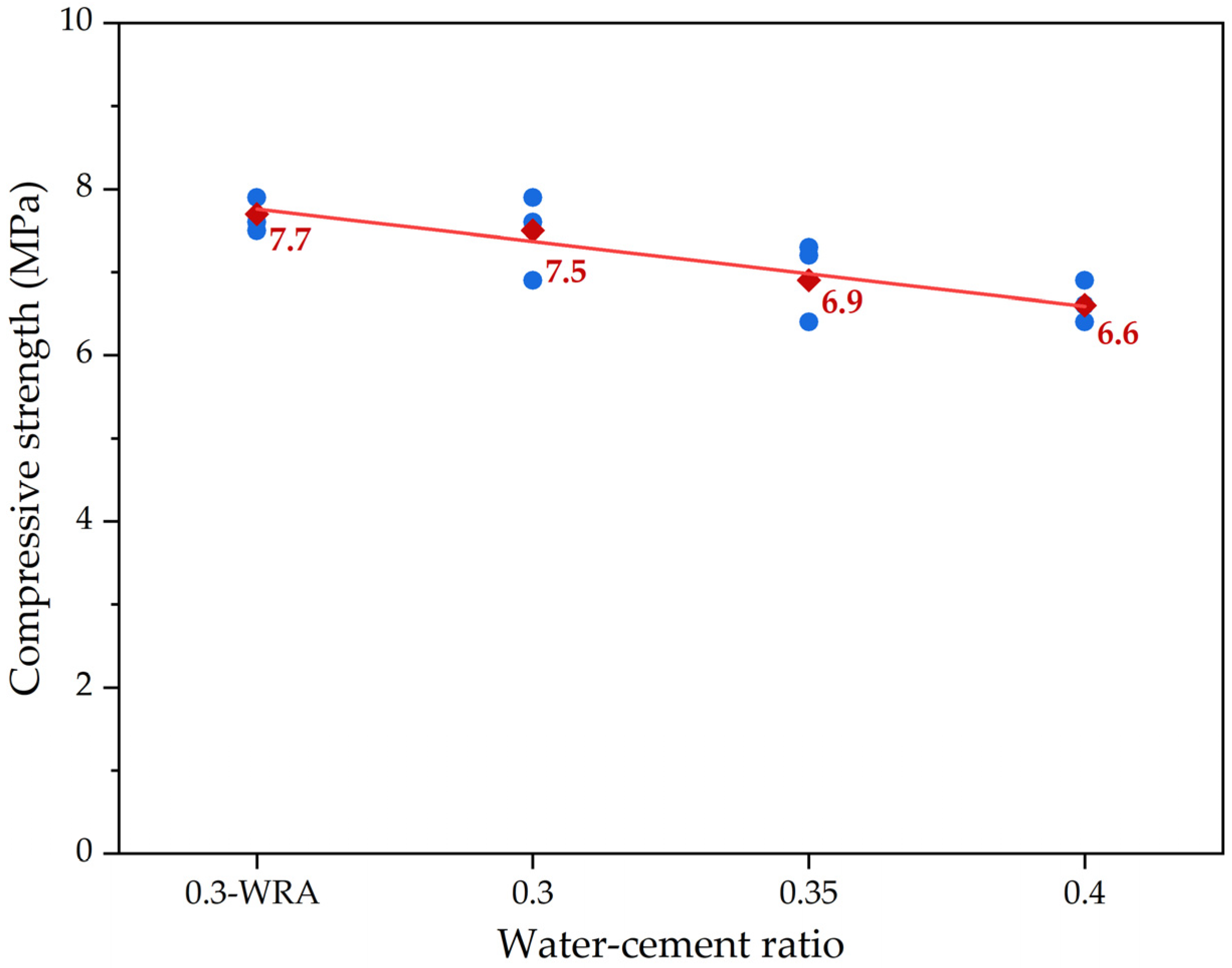
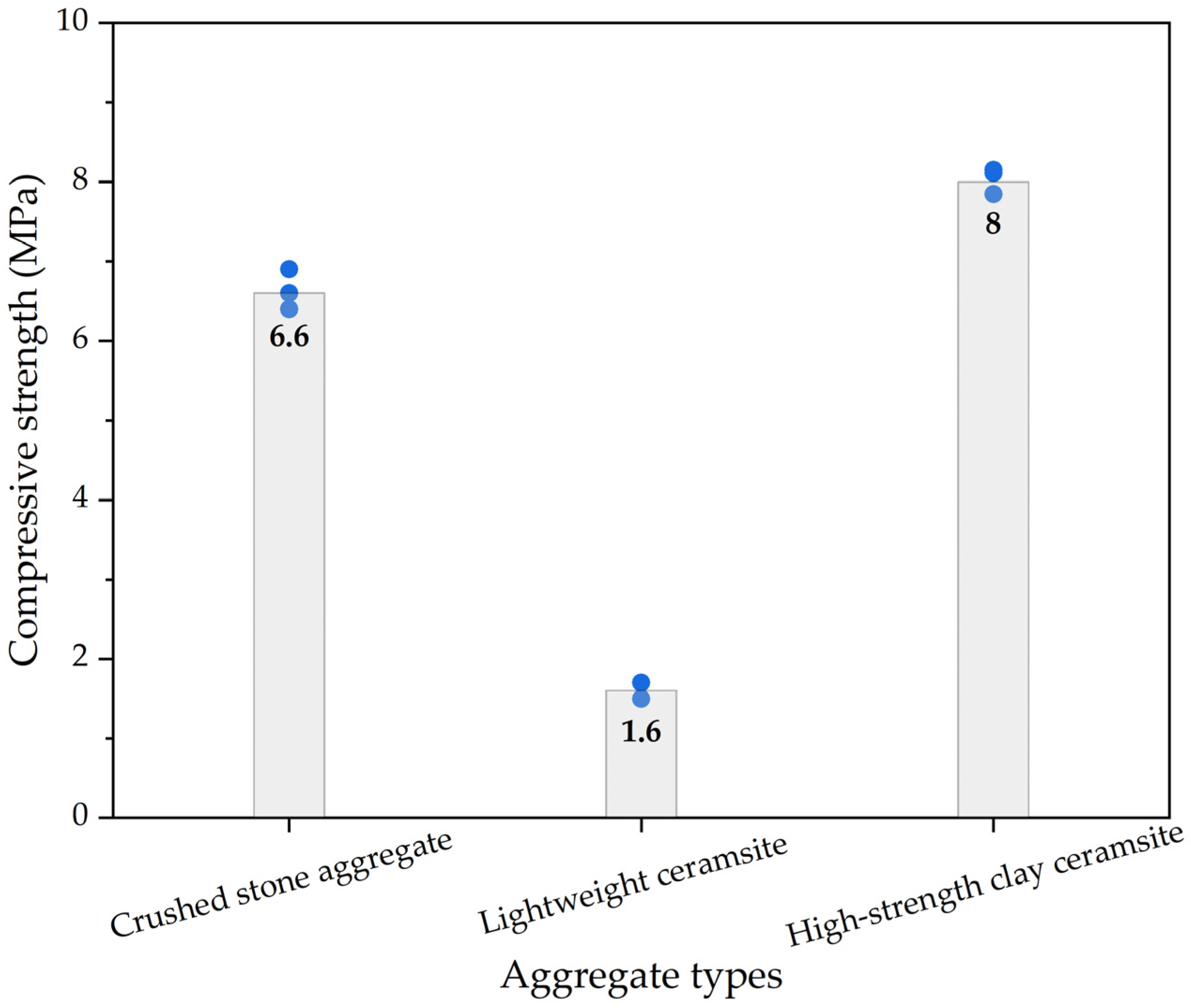

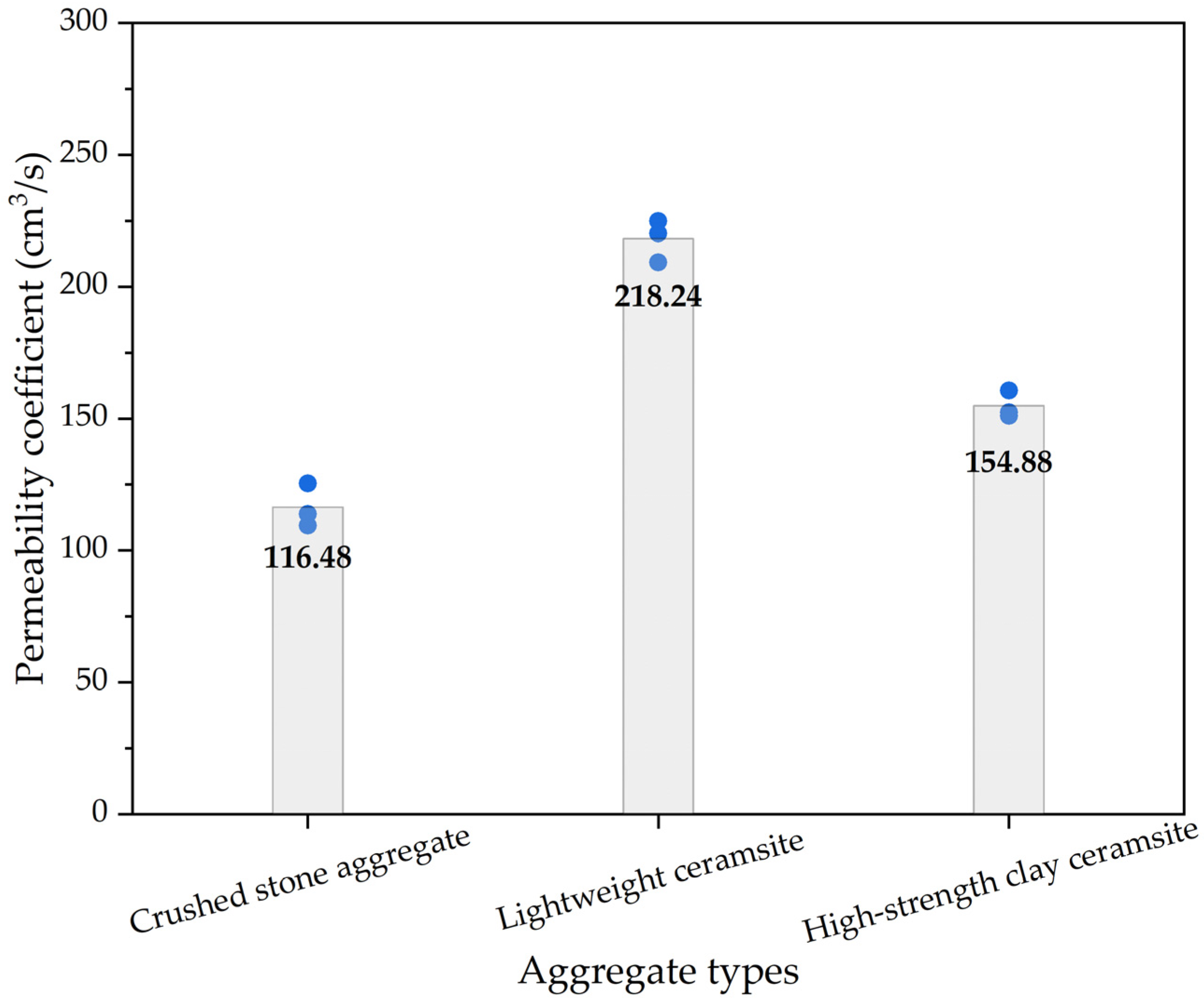
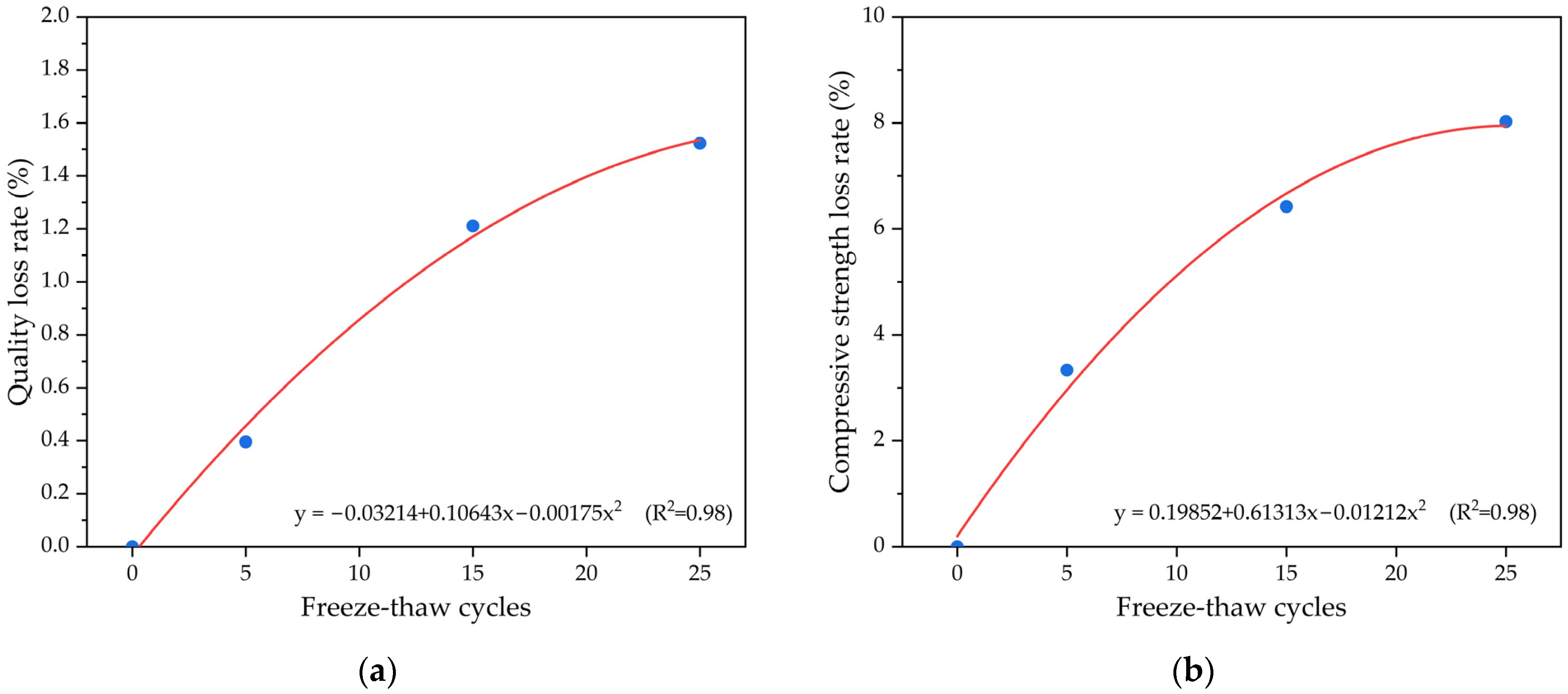

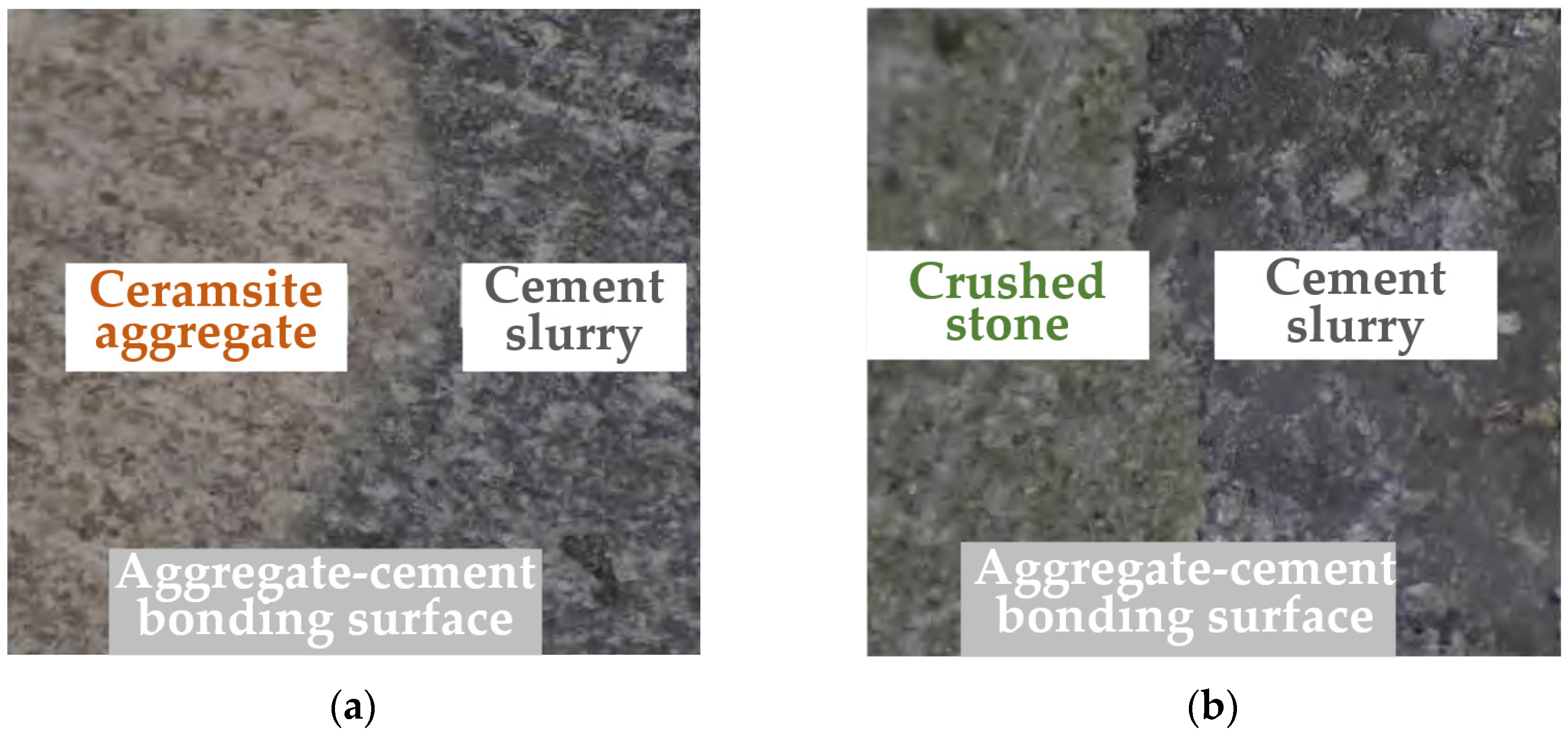
| Property | Density (g/cm3) | Setting Time (h) | Flexural Strength (MPa) | Compressive Strength (MPa) | |||
|---|---|---|---|---|---|---|---|
| Initial | Final | 7 d | 28 d | 7 d | 28 d | ||
| Test | 2.9 | 1 | 4 | 4.75 | 7.65 | 23.6 | 43.5 |
| Requirements | - | ≥0.75 | ≤6.5 | ≥4.0 | ≥6.5 | ≥22.0 | ≥42.5 |
| Type | Density (g/cm3) | Bulk Density (g/cm3) | Crushing Value (%) | Strength (MPa) |
|---|---|---|---|---|
| Ordinary crushed stone | 2.32 | 1.44 | 11.3 | 4.8 |
| Lightweight ceramsite | 0.37 | 0.22 | 86.4 | 0.12 |
| High-strength clay ceramsite | 1.80 | 1.10 | 10.8 | 5.2 |
| Aggregate Type | Cement (kg) | Water–Cement Ratio | Water (kg) | Aggregate (kg) | Porosity (%) |
|---|---|---|---|---|---|
| Ordinary crushed stone | 200 | 0.30 | 54 (WRA) | 1440 | 25.3 |
| 200 | 0.30 | 60 | 1440 | 25.1 | |
| 200 | 0.35 | 70 | 1440 | 24.1 | |
| 200 | 0.40 | 80 | 1440 | 23.1 | |
| Lightweight ceramsite | 200 | 0.40 | 80 | 220 | 26.1 |
| High-strength clay ceramsite | 200 | 0.40 | 80 | 1100 | 24.1 |
Disclaimer/Publisher’s Note: The statements, opinions and data contained in all publications are solely those of the individual author(s) and contributor(s) and not of MDPI and/or the editor(s). MDPI and/or the editor(s) disclaim responsibility for any injury to people or property resulting from any ideas, methods, instructions or products referred to in the content. |
© 2023 by the authors. Licensee MDPI, Basel, Switzerland. This article is an open access article distributed under the terms and conditions of the Creative Commons Attribution (CC BY) license (https://creativecommons.org/licenses/by/4.0/).
Share and Cite
Gao, S.; Huang, K.; Chu, W.; Wang, W. Feasibility Study of Pervious Concrete with Ceramsite as Aggregate Considering Mechanical Properties, Permeability, and Durability. Materials 2023, 16, 5127. https://doi.org/10.3390/ma16145127
Gao S, Huang K, Chu W, Wang W. Feasibility Study of Pervious Concrete with Ceramsite as Aggregate Considering Mechanical Properties, Permeability, and Durability. Materials. 2023; 16(14):5127. https://doi.org/10.3390/ma16145127
Chicago/Turabian StyleGao, Shan, Kainan Huang, Wenchao Chu, and Wensheng Wang. 2023. "Feasibility Study of Pervious Concrete with Ceramsite as Aggregate Considering Mechanical Properties, Permeability, and Durability" Materials 16, no. 14: 5127. https://doi.org/10.3390/ma16145127
APA StyleGao, S., Huang, K., Chu, W., & Wang, W. (2023). Feasibility Study of Pervious Concrete with Ceramsite as Aggregate Considering Mechanical Properties, Permeability, and Durability. Materials, 16(14), 5127. https://doi.org/10.3390/ma16145127







